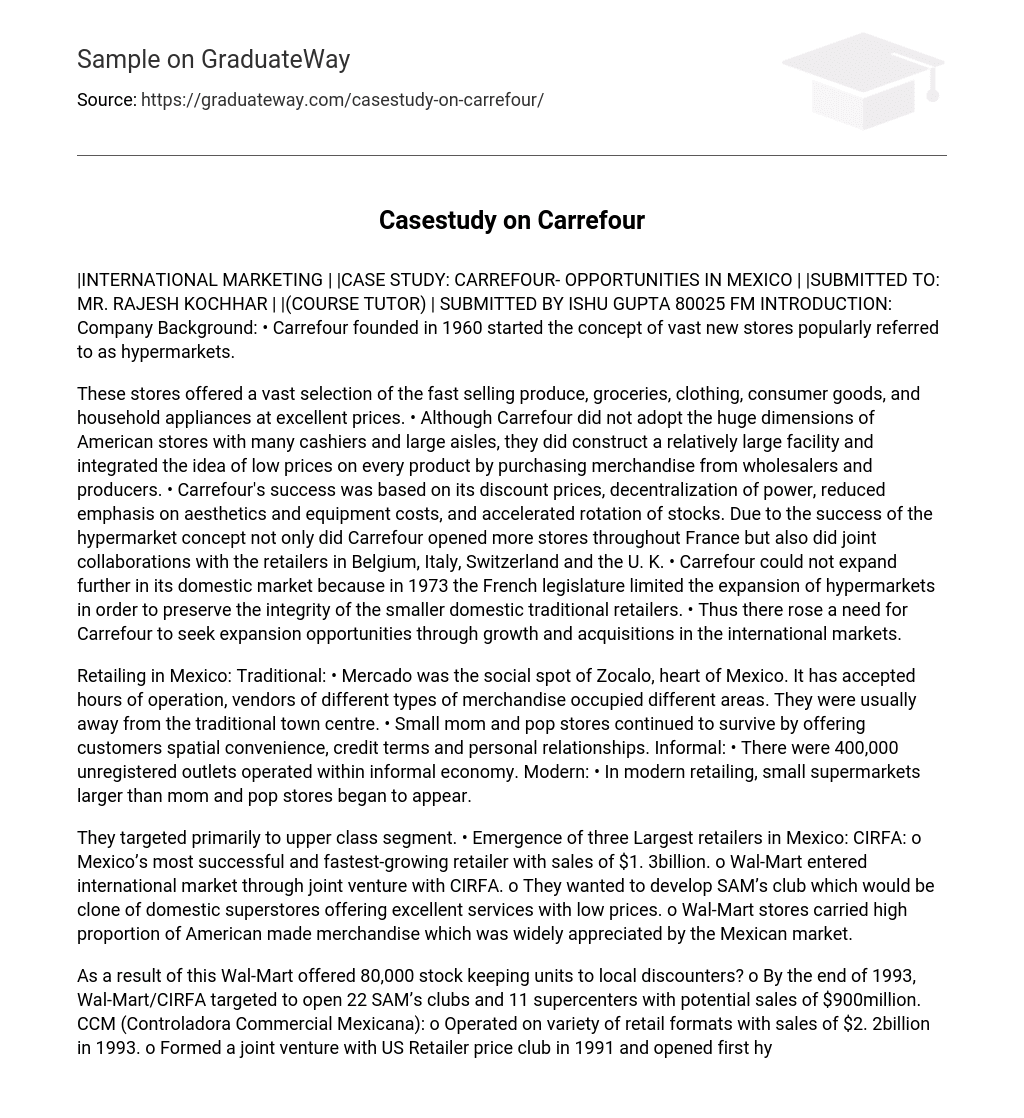Carrefour founded in 1960 started the concept of vast new stores popularly referred to as hypermarkets. These stores offered a vast selection of the fast selling produce, groceries, clothing, consumer goods, and household appliances at excellent prices. Although Carrefour did not adopt the huge dimensions of American stores with many cashiers and large aisles, they did construct a relatively large facility and integrated the idea of low prices on every product by purchasing merchandise from wholesalers and producers.
Carrefour’s success was based on its discount prices, decentralization of power, reduced emphasis on aesthetics and equipment costs, and accelerated rotation of stocks. Due to the success of the hypermarket concept not only did Carrefour opened more stores throughout France but also did joint collaborations with the retailers in Belgium, Italy, Switzerland and the U. K.
Carrefour could not expand further in its domestic market because in 1973 the French legislature limited the expansion of hypermarkets in order to preserve the integrity of the smaller domestic traditional retailers. Thus there rose a need for Carrefour to seek expansion opportunities through growth and acquisitions in the international markets.
Retailing in Mexico: Traditional: Mercado was the social spot of Zocalo, heart of Mexico. It has accepted hours of operation, vendors of different types of merchandise occupied different areas. They were usually away from the traditional town centre. Small mom and pop stores continued to survive by offering customers spatial convenience, credit terms and personal relationships. Informal: There were 400,000 unregistered outlets operated within informal economy. Modern: In modern retailing, small supermarkets larger than mom and pop stores began to appear.
They targeted primarily to upper class segment. Emergence of three Largest retailers in Mexico: CIRFA: Mexico’s most successful and fastest-growing retailer with sales of $1. 3billion. Wal-Mart entered international market through joint venture with CIRFA. They wanted to develop SAM’s club which would be clone of domestic superstores offering excellent services with low prices. Wal-Mart stores carried high proportion of American made merchandise which was widely appreciated by the Mexican market.
As a result of this Wal-Mart offered 80,000 stock keeping units to local discounters? By the end of 1993, Wal-Mart/CIRFA targeted to open 22 SAM’s clubs and 11 supercenters with potential sales of $900million. CCM (Controladora Commercial Mexicana): Operated on variety of retail formats with sales of $2. 2billion in 1993. Formed a joint venture with US Retailer price club in 1991 and opened first hypermarket style store called Price club de Mexico in 1992. oLike CIFRA, the expansion plans were to open 8 new stores in 1994 with sales of $400million.
Grupo Gigante It was the third largest retailer with sales of $2. 6billion. o It also had the foreign partnership and operated in 42 Radio Shack stores in a joint venture with Tandy Corporation. Others Fourth largest player was Soriana. Hypermarkets, discount warehouse stores, supermarkets and other large format stores increased their market share by 15 percent. Sales through hypermarkets had grown by 897percent, supermarkets 260 percent, and general stores 47 percent.
The Mexican Economy and Consumer Patterns: 1994 Increase in population during the period 1960 to 1990 was from 50. 7% to 71. 3%. • 85 percent of population was below poverty line which made wide difference in spending habits of different sectors of population. • Upper class consumers had extra disposable income. They frequently travelled to US to shop for merchandise. Large lower classes did not have access to same opportunities as did not have cars to travel to stores nor they have storage space to keep large amounts of staple food. Middle class was expanding and need for foreign made goods were growing.
Imbalance of trade: There was increase of export by 53. 2 percent and imports by 91. 7 percent. Trade deficit had grown by $13. 5 billion in 1993. Number of food retail outlets had grown by 14. 4percent in 1993 and non-food outlets had only increased by 6. 6 percent. Total retail sales had increased by 62 percent between 1990 and 1993. The four largest Mexican retailers (CIRFA, CCM, Gigante, and Soriana) increased their total selling area by 69 percent.





